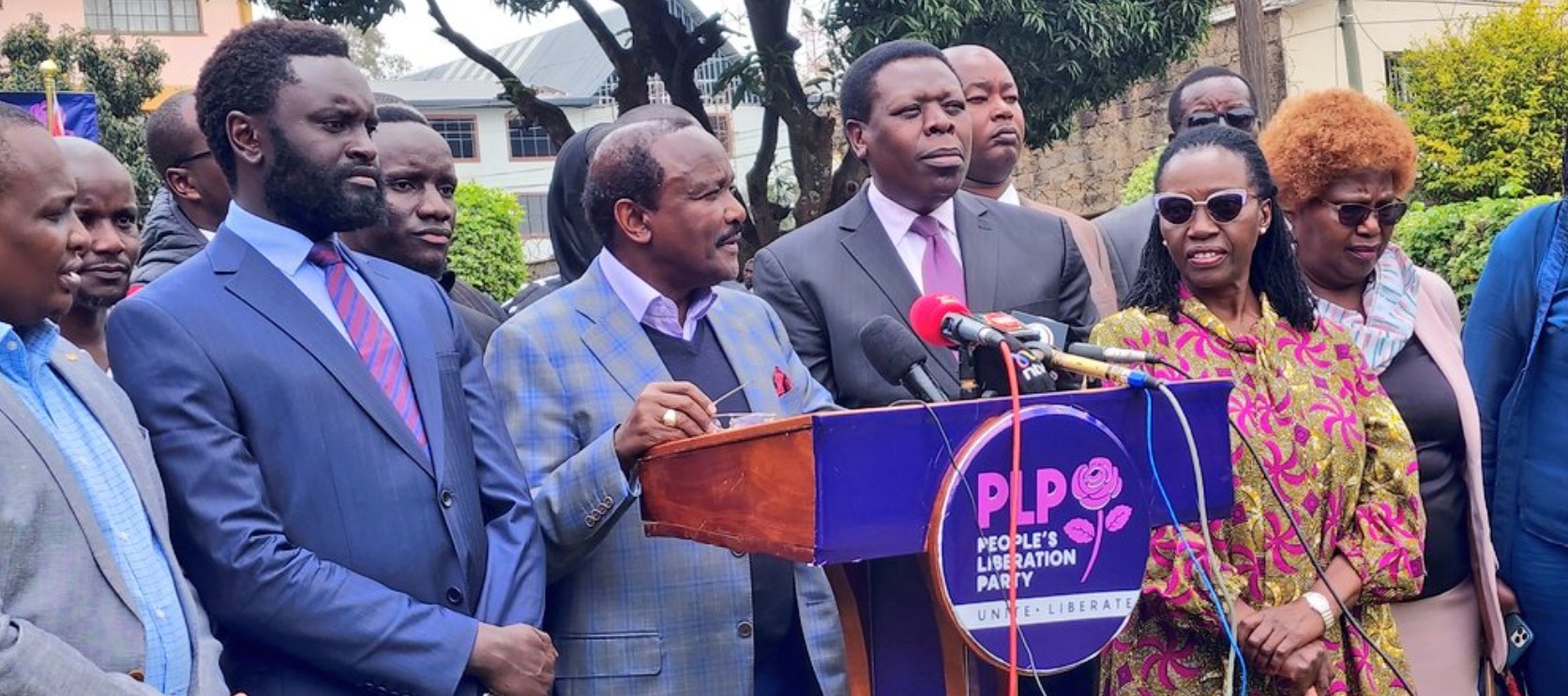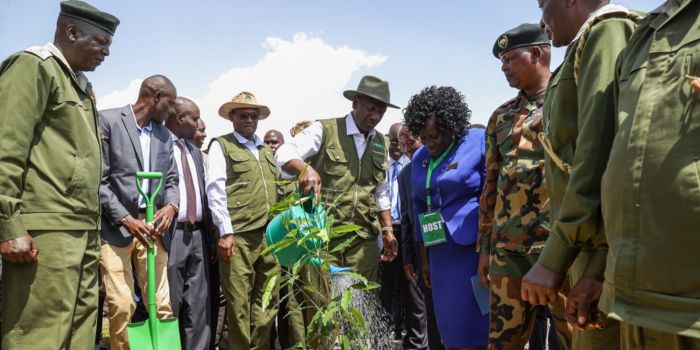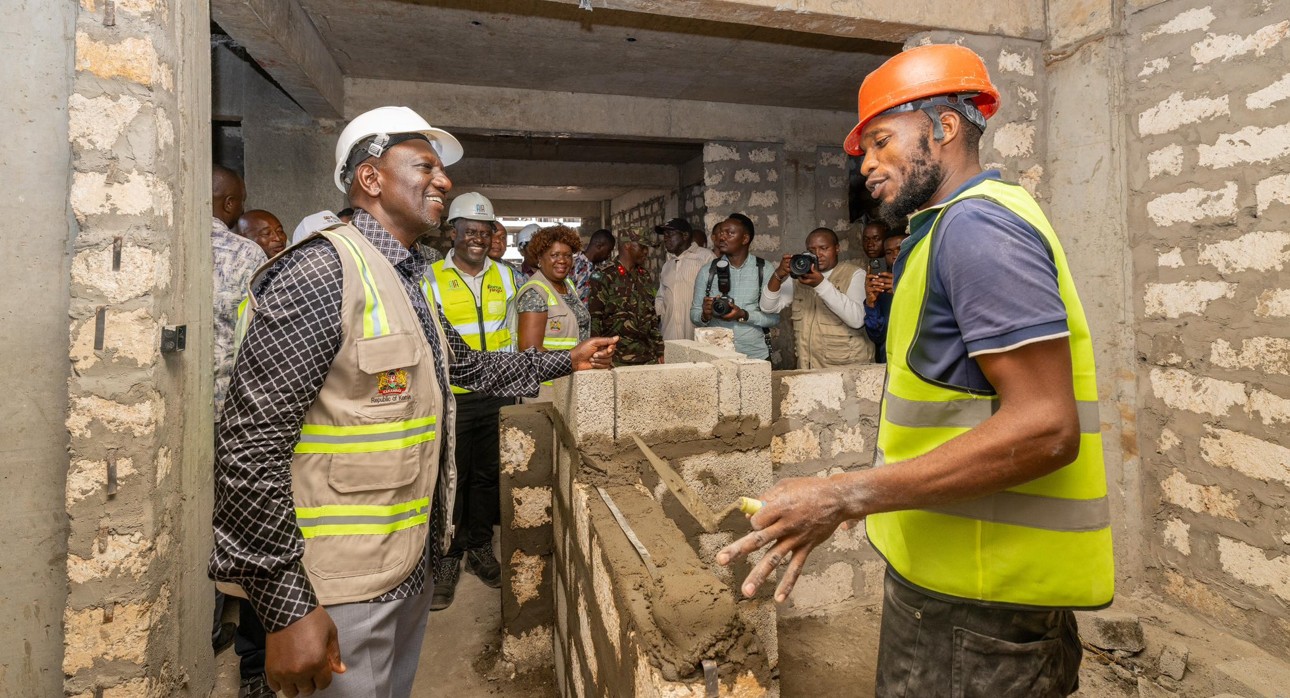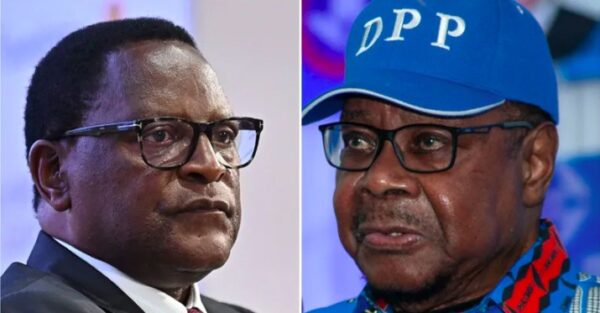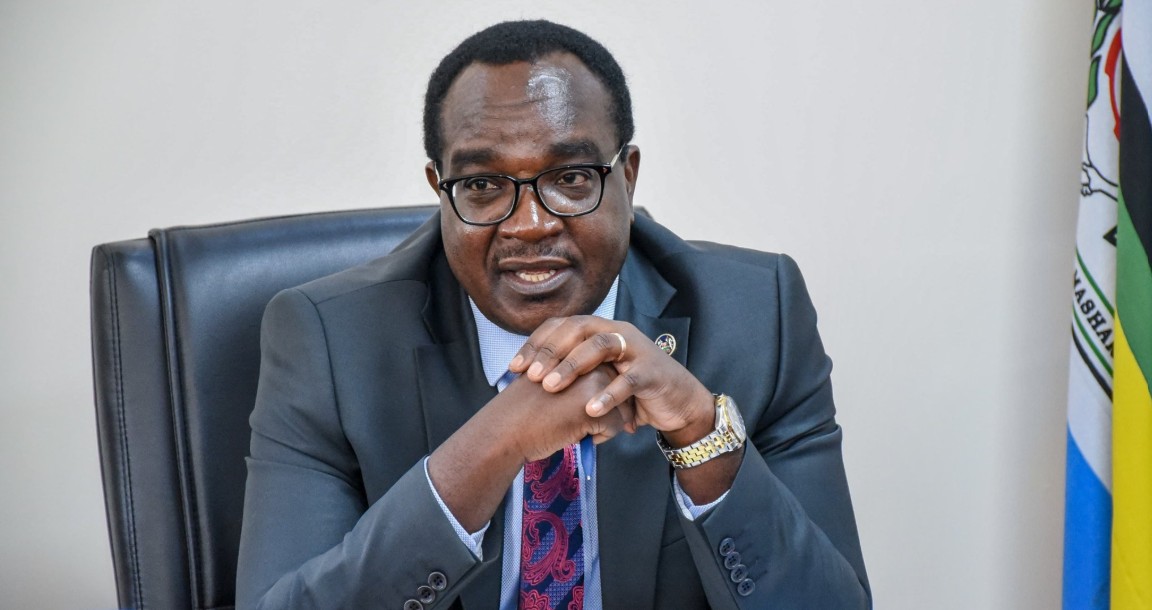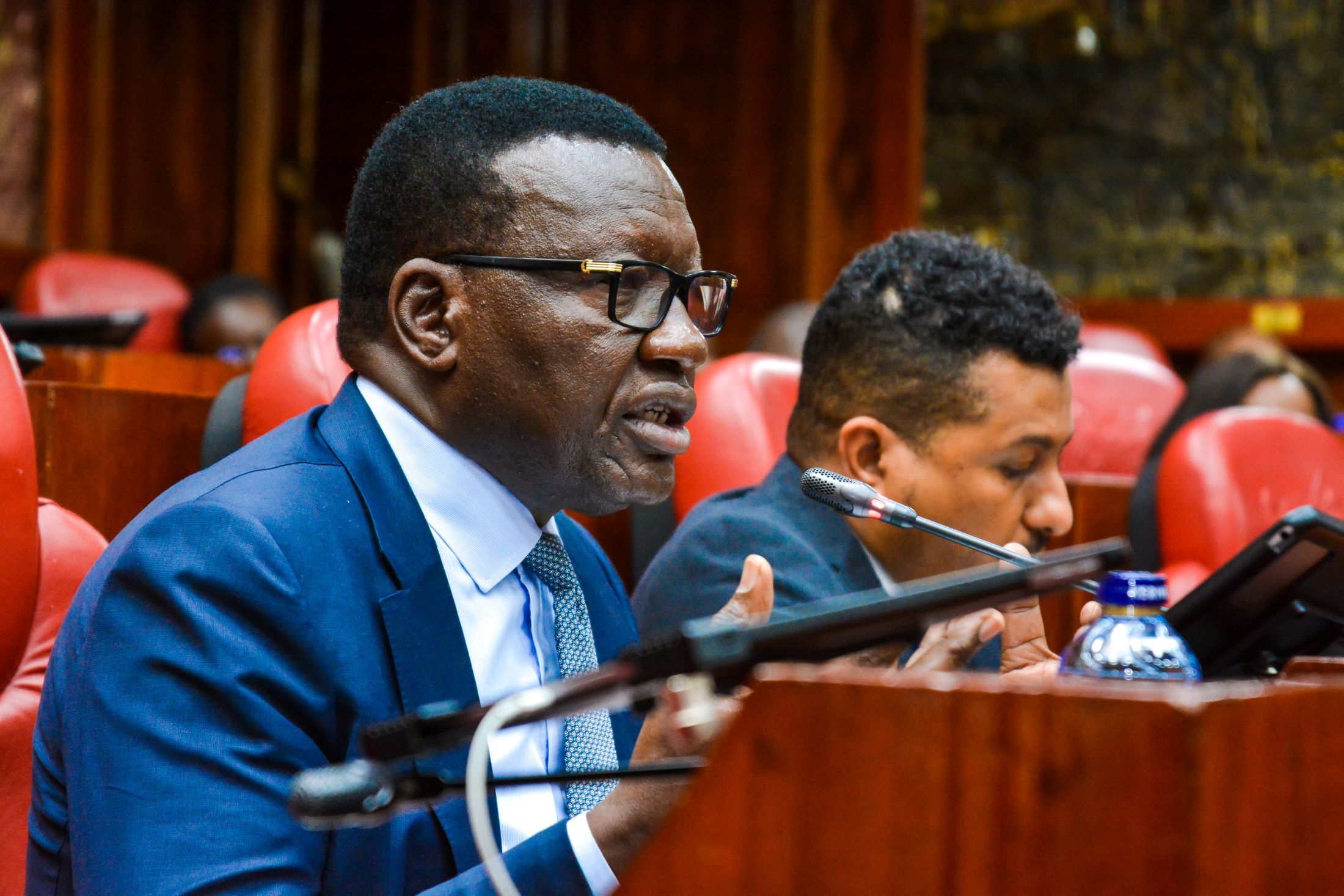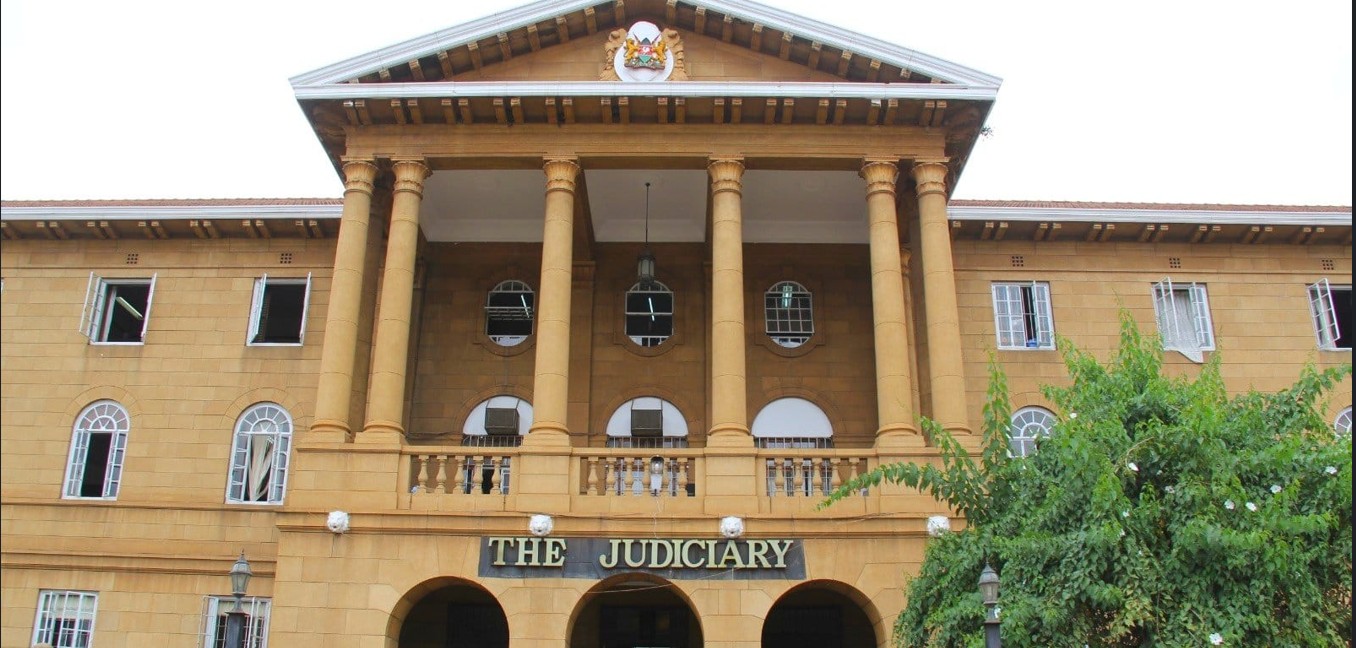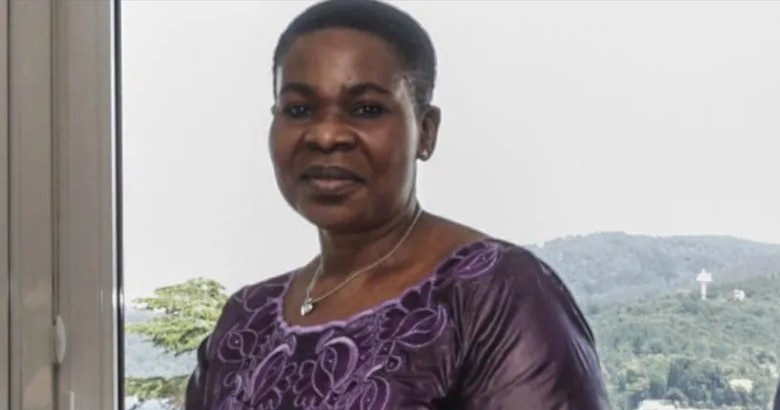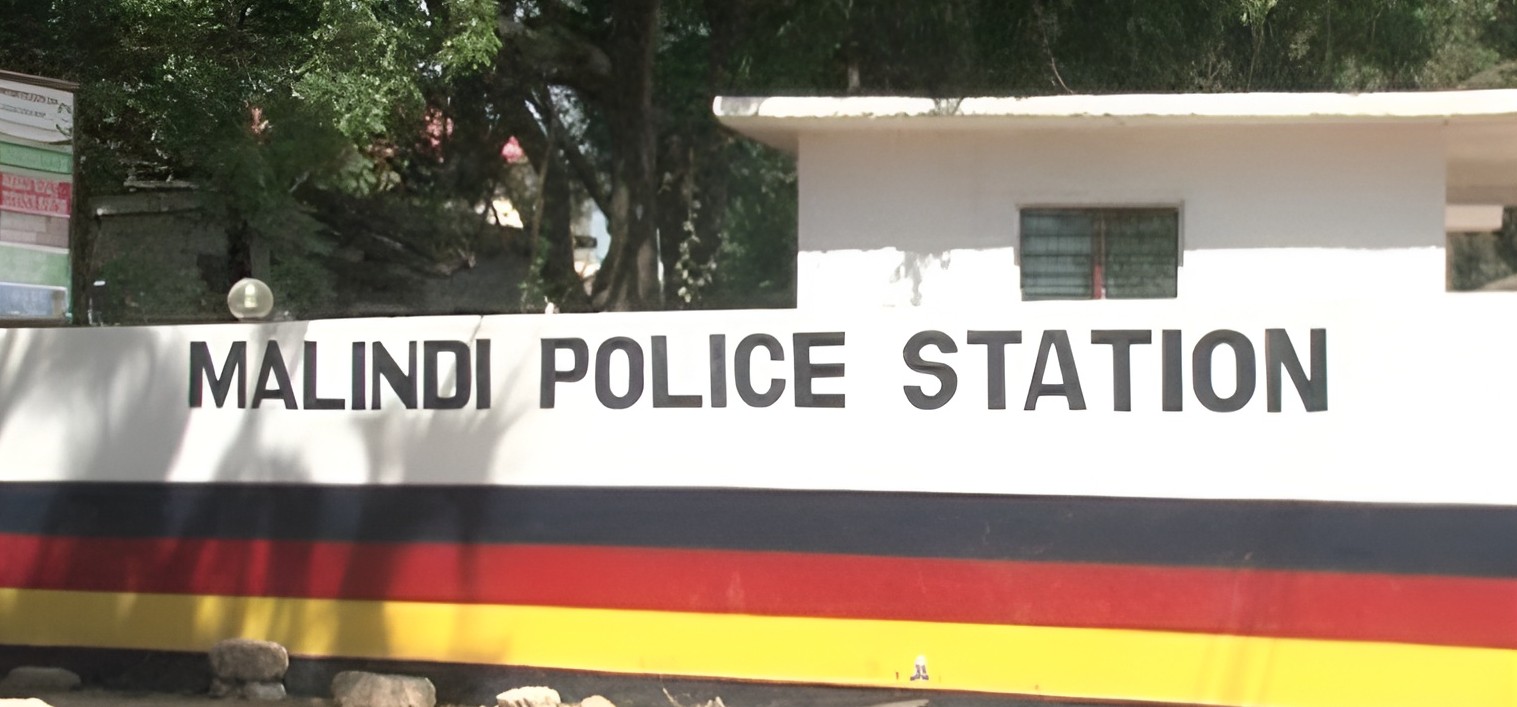Kenya's security forces abducted, killed protesters - Human Rights Watch
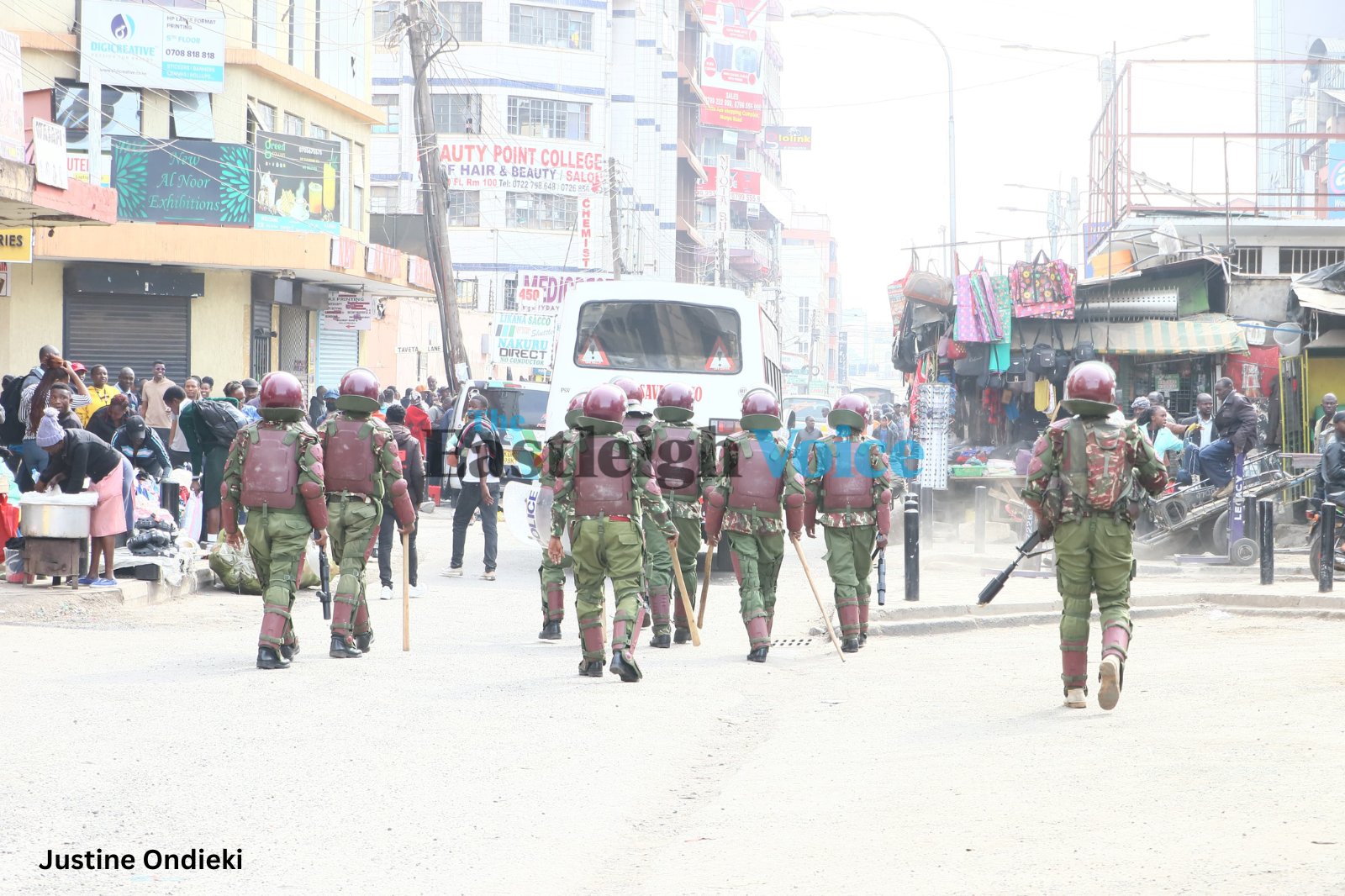
Kenyan security forces abducted, arbitrarily arrested, tortured, and killed perceived leaders of the anti-Finance Bill protests between June and August 2024, Human Rights Watch said Tuesday. Security officers held abductees, who they had detained without respecting their legal rights, in unlawful detention facilities, including in forests and abandoned buildings, and denied them access to their families and lawyers.
The protests, organised largely by people between the ages of 18 and 35, began weeks earlier but gained momentum after the introduction of the Finance Bill 2024 in parliament on June 18, as protesters expressed outrage over provisions that would raise taxes on essential goods and services to meet International Monetary Fund revenue targets. On June 25 at about 2:30 p.m., a crowd estimated by the security team at parliament to have been between 3,000 to 4,000 people broke through the parliament fence, where they encountered anti-riot police officers, who shot directly at the crowd, killing several. The protesters overpowered the police and entered parliament through the back entrance, destroying furniture and other items.
More To Read
- Pentecostal Voice of Kenya warns of worsening corruption, lawlessness in Kenya
- Terrorism or protest? What Kenyan law says about anti-government demos and charges
- That’s not me – police officer accused of shooting Rex Masai claims mistaken identity
- NCIC blames youth exclusion, poor leadership for deadly Gen Z protests, urges national dialogue
- Lobby demands independent inquiry into protest deaths, including Albert Ojwang’s custody case
- Over 1,000 national ID cards destroyed in fire during protests in Ol Kalou
“The ongoing deadly crackdown on protesters further taints Kenya’s already dismal human rights record,” said Otsieno Namwaya, associate Africa director at Human Rights Watch. “The authorities should end the abductions, publicly denounce rhetoric that attempts to criminalize peaceful protests, and ensure prompt investigation and fair prosecution of security officers credibly implicated in the abuses.”
President William Ruto described the protesters’ action as an “invasion” and treason. On June 26 the president withdrew the bill, but police continue to track and abduct social media activists believed to be protest leaders and protesters whose faces were caught on CCTV cameras at parliament.
Between August and September, Human Rights Watch interviewed 75 people in the Mathare, Kibera, Rongai, Mukuru Kwa Njenga, and Githurai neighbourhoods of Nairobi, the Kenyan capital. They included former abductees, witnesses, journalists, parliamentary staff, relatives of abducted and missing people, other protesters, human rights activists, and police officers.
The interviewees described how, several weeks after the protests, security officers in civilian clothes with their faces concealed were still hunting down, forcibly disappearing, and killing perceived protest leaders. Witnesses and survivors of abductions said abductors drove unmarked cars whose registration plates were repeatedly changed, making it difficult to trace the owners.
Human Rights Watch research shows that the officers were largely drawn from the Directorate of Criminal Investigations, supported by the Rapid Deployment Unit, military intelligence, the Anti-Terrorism Police Unit, and the National Intelligence Service.
The abductees said they were seized from their homes, jobs, and the street, and detained for prolonged periods without being charged, even though Kenyan law requires the arraignment of suspects in court within 24 hours.
A 28-year-old protester said he was picked up during the protests on June 27 by men in civilian clothes with covered faces. He was detained briefly at Nairobi’s central police station, then taken with other people to an abandoned building at a location he did not recognize. “The place looked like it was used for torture, with blood stains on the floor,” he said. “About eight armed officers threw me on the floor and beat me with their gun butts on my ribs and kicked me for like two hours until I bled. They threatened to kill me while asking ‘Who is funding this thing? Who is supporting you, protesters?’”
In August, the state-funded Kenya National Commission on Human Rights said it had documented at least 73 abductions. However three senior staff told Human Rights Watch that they stopped public updates due to threats and pressure from senior government officials. While some of those abducted have been released, worried relatives of other missing people, who they suspect to have been abducted by security forces, continue to search for them.
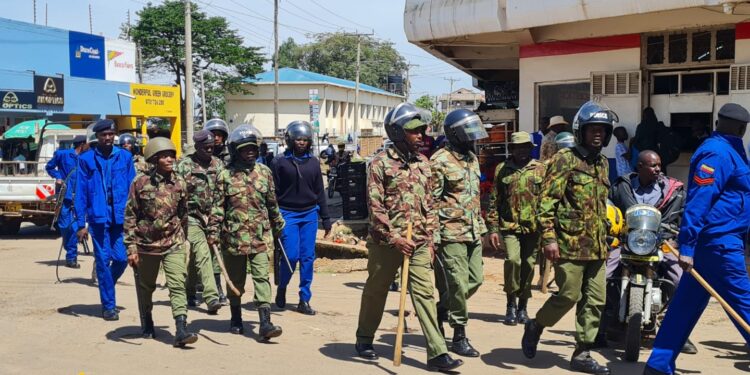 Police patrol streets in Kakamega during the June 2024 protests. (Photo: Handout)
Police patrol streets in Kakamega during the June 2024 protests. (Photo: Handout)Police patrol streets in Kakamega during the June 2024 protests. (Photo: Handout)
Bodies of some of those reported missing have been found in rivers, forests, abandoned quarries, and mortuaries; showing signs of torture, with some mutilated and dismembered. Multiple people interviewed by Human Rights Watch, including former detainees, said the police accused them of attempting to overthrow the government and threatened to kill them if they did not disclose the identities of protest leaders and funders.
Several victims said that police officers punched, slapped, kicked, and beat them with rubber whips, sticks, plastic pipes, and in some instances butt stocks of firearms. At least two people said police officers used pliers to pull out their pubic hair and nails during interrogation. Nearly all people previously detained said police denied them food and water, and asked families to pay between Ksh3,000 (US$23) and Ksh10,000 ($76.9) in bribes for their release.
Some family members who witnessed abductions said they could not locate relatives abducted by people they believed to be police in civilian clothes. Others said they saw police who shot their relatives dead taking the bodies away.
A 25-year-old man said he saw men in civilian clothes that he believed to be police as they were communicating on the police radio, snatch his 28-year-old brother, Brian Kamau, in the Githurai neighbourhood: “They were three men in plainclothes wearing balaclavas. They kicked, punched, and stepped on Brian before they forcefully bundled him into a Subaru car and sped off. That was the last time I saw him.”
The authorities should provide information to families about the whereabouts of missing relatives, Human Rights Watch said. Under the International Convention for the Protection of All Persons from Enforced Disappearances, no one should be subjected to enforced disappearance and no exceptional circumstances, even a state or threat of war, may be invoked as justification. An enforced disappearance is defined as the arrest, detention, or abduction of persons by state forces, or with the authorization or support of the state, followed by a refusal to acknowledge the detention or give information on the fate or whereabouts of the person when asked.
Kenyan authorities should immediately end these abuses and facilitate investigations into the abductions and killings of protesters by an independent tribunal made up of Kenyans and non-Kenyans, including lawyers, judges, and investigators. Kenya’s international partners should press the authorities to respect the right to peaceful protest and create an environment conducive to independent investigations.
Under the United Nations’ Basic Principles on the Use of Force and Firearms by Law Enforcement Officials, police and other law enforcement officials should always identify themselves, and avoid use of force on peaceful protesters or restrict such force to the minimum extent necessary. Lethal force should only be used when strictly necessary to prevent an imminent threat to life. Police should also not use excessive force on detainees in their custody.
“The Kenyan government needs to end the culture of abusive law enforcement that has defined protests in Kenya for the past two decades,” Namwaya said. “President Ruto should publicly disavow abusive police conduct and ensure independent investigations and prosecutions for these abuses.”
For witness accounts and other details, please see below. The names of those interviewed have been withheld for their protection.
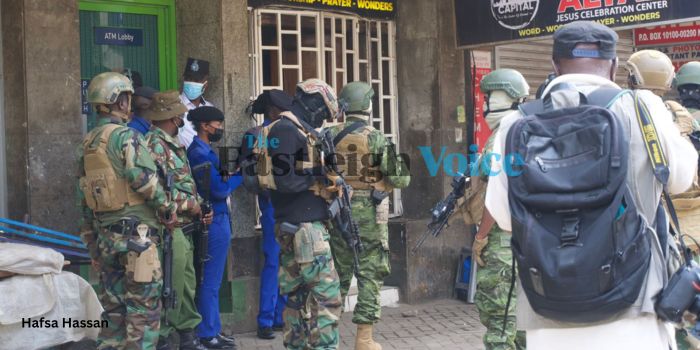 Police officers at the KCB along Tom Mboya Street in Nairobi, near Archives, on July 2, 2024, following reports of gunshots amid protests against the government. (Photo: Hafsa Hassan/EV)
Police officers at the KCB along Tom Mboya Street in Nairobi, near Archives, on July 2, 2024, following reports of gunshots amid protests against the government. (Photo: Hafsa Hassan/EV)
The Kenya protests were a culmination of public tensions that had been growing since 2023 when the main opposition groups held protests against the rising cost of living. The bill that set off the 2024 protests would have made heavy cuts to essential services like health, education, and infrastructure, such as roads while increasing funds for travel and hospitality in the office of the president and his deputy. The proposals also included budgetary allocations for unconstitutional offices such as the offices of the president and deputy president’s wives.
During hearings in public participation, parliament found that more than 70 per cent of the population opposed the proposals. Initial low-level public protests, with sparse crowds and limited media coverage, intensified after June 18, when it became clear that lawmakers would adopt the bill. The protests culminated in the occupation of parliament on June 25, when protesters learned that parliament had adopted the bill.
Criminalization of the Right to Protest
In a public address on the evening of June 25, President Ruto described the action of protesters as an “unprecedented attack on its democracy [and] rule of law” and a threat to national security, describing the protesters as “dangerous criminals” and “treasonous.” He added that he was putting the planners, financiers, and orchestrators of the violence on notice.
The president withdrew the Bill on June 26 and offered to hold a dialogue with the protesting youths. Security forces had already begun cracking down, however, with arbitrary arrests, abductions, enforced disappearances, and killings of suspected leaders of protests and social media activists. President Ruto denied knowledge of abductions or enforced disappearances, promising that, “if there is a family … [whose] child, or their friend, or their relative went to a demonstration, whether it is last year or this year, and never came back, I want … their names. I will take firm and decisive action. I don’t have a single name of somebody who has been abducted or disappeared.”
Although Kenya’s constitution guarantees the right to peaceful protest, the authorities appear to have treated protests as crimes even before the brief occupation of parliament on June 25. Speaking to parliament on September 26, then-interior cabinet secretary, Kindiki Kithure, who is now deputy president, said that at least 1,208 people had been arrested across Kenya during the protests and that 132 were missing, but Kenyan human rights groups said that the numbers are much higher.
Protesters who were formally detained said police arrested them as they chanted “reject Finance Bill” while carrying water and handkerchiefs, including at parliament, as opposed to causing violence. They said police demanded bribes for their release.
A 24-year-old expectant mother said: “The officers at Kamukunji station asked me to call my mother and ask for Ksh10,000 ($76.9) so they can release me. My mom said she only had Ksh3,000 ($23). After some haggling, they accepted the money and released me.” Numerous other protesters interviewed, including those held at other police stations, had similar accounts.
The police have arrested people who submitted to them any notice of intention to protest, as required by law. Activists Bob Njagi and Aslam Longton had signed a letter notifying police about plans to protest on August 20 over land irregularities in Kitengela, a neighbourhood about 40 kilometres from downtown Nairobi. On August 19, plainclothes men with covered faces, whom the brothers identified as security officers since they had pistols, communicated on police radio and questioned them about financiers of protests, abducted Aslam and his brother, Jamil Longton, in Kitengela, and held them for 32 days.
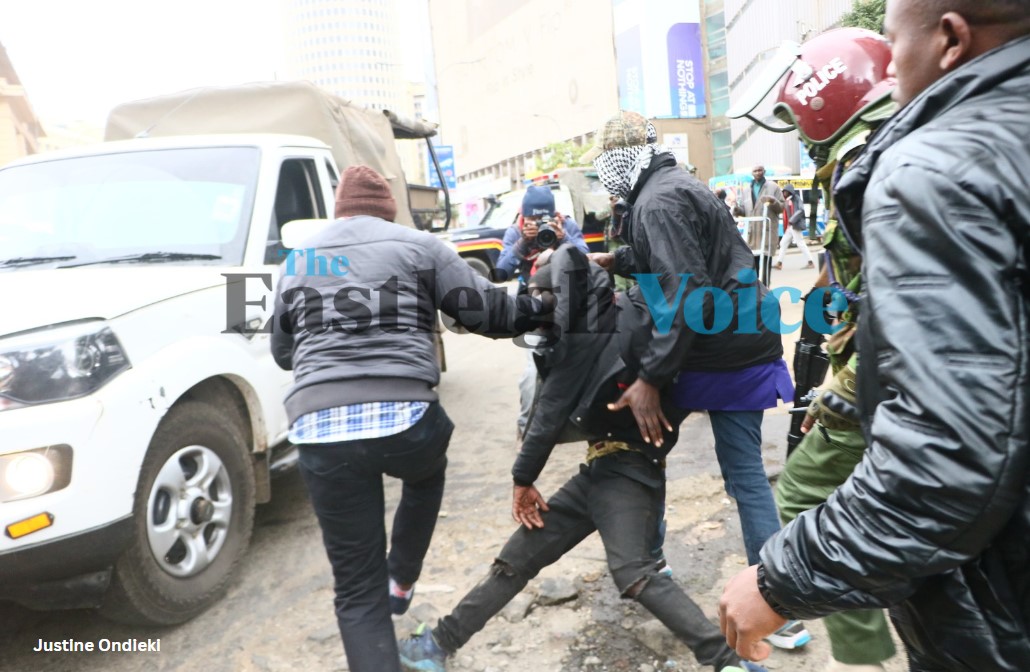 Plainclothes police officers arrest protesters along Tom Mboya Street during the #NaneNaneMarch on Thursday, August 8, 2024. (Photo: Justine Ondieki)
Plainclothes police officers arrest protesters along Tom Mboya Street during the #NaneNaneMarch on Thursday, August 8, 2024. (Photo: Justine Ondieki)Plainclothes police officers arrest protesters along Tom Mboya Street during the #NaneNaneMarch
On the same day, another team of plainclothes officers flagged down a public transport vehicle from which they abducted Njagi. Njagi and the Longtons said they were held at what they described as a house with wooden floors, along with detainees from other parts of the country, including Garissa, Isiolo, and Wajir.
Prolonged Detention, Surveillance, Intimidation, and Threats
Although Kenyan law allows police to hold suspects for no more than 24 hours without taking them to court, police detained protesters for weeks in police cells and unregistered places such as forests, abandoned buildings, and warehouses. Kenyan authorities also deployed security personnel to track, surveil, intimidate, and threaten protesters and social media activists. Many people interviewed said that people they believed to be security officers had tracked them and kept them under surveillance.
A 23-year-old protester said: “I feel there are two people whose faces have become familiar that are following me. They look like police officers.” A 19-year-old man expressed similar fears: “I am being followed. It has affected me because I don’t feel at ease. I live in fear.”
Another 23-year-old protester said in September that a friend with whom he participated in protests at parliament had expressed fears for his life after he noticed he was being followed: “A car often stops and the occupants just look at him. He went into hiding at another friend’s place in Korogocho for two weeks, but the surveillance hasn’t stopped.”
Former police detainees said police officers threatened to kill them if they were found protesting. “I will just live normally until they come to kill me,” said a 24-year-old man. “I know I am a marked person.” A 22-year-old man who was arrested on June 25 by four police officers in civilian clothes driving a black minivan said the officers told him during interrogation that he would end up like those whose bodies were found in the Mukuru Kwa Njenga quarry if he did not cooperate.
“Police deliberately brought street thugs to terrorize us in our cell,” said a former detainee, age 22. “They would beat us, or defecate on their hands and smear us, or threaten to sodomize us. They were 10 of them and wild.”
A 32-year-old man who protested at parliament on June 25 said police showed him pictures from parliament CCTV cameras, which they used to track him and others. Three senior Kenya National Commission on Human Rights staff members said the commission had written to parliamentary leadership requesting CCTV videos to aid their investigations on killings during protests at parliament, but the authorities at parliament said the cameras had malfunctioned.
Denial of Food, Beatings, and Torture
Human Rights Watch found that police officers beat detainees, denied them food and water, and tortured some to extract information about who was leading and financing the protests. People interviewed said security officers forced them to sleep on cold concrete floors without clothes or bedding for weeks, which made several of them ill.
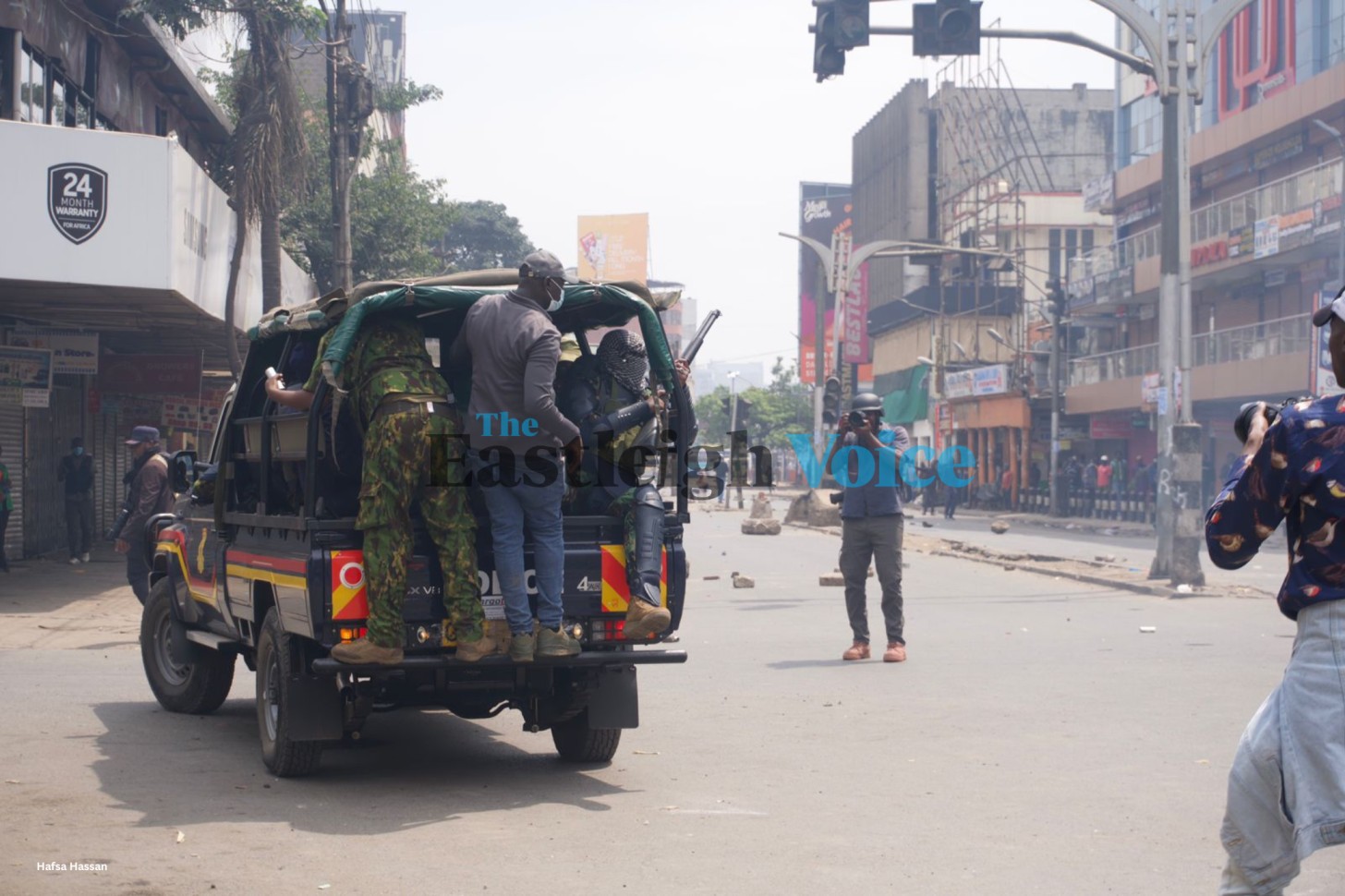 Police disperse protesters in Nairobi on Tuesday, July 2, 2024. (Photo: EV)
Police disperse protesters in Nairobi on Tuesday, July 2, 2024. (Photo: EV)Police disperse protesters in Nairobi on Tuesday, July 2, 2024. (Photo: Hafsa Hassan)
Some said the officers kept them chained on metal rails in abandoned buildings overnight, depriving them of sleep, and denied them food, water, and access to doctors, including those who had become ill or were injured from beatings and gunshots.
A 31-year-old protester who was arrested on a street in Nairobi on June 25 said: “I was made to sleep on cold concrete floor with my hands bound and nothing to cover myself. My clothes were torn. They beat me with a sharp object. My leg has not healed to this day. They did not give us food for three days. They brought a glass of water once.”
Another protester arrested on June 25 said that police held him for one day at Kamukunji police station, then blindfolded him and drove for three hours to a place he did not recognize. He said police interrogated him there for three days about who was leading and financing the protests, then abandoned him by the roadside: “One police officer sat me down, uncuffed me, and removed my blindfolds. I realized I was in Mwea–Karatina junction, some 120 kilometres from … Nairobi.”
Another protester said in August that he was still nursing broken ribs, caused by beatings while in police custody in June. A 24-year-old man said a female police officer at Nairobi’s central police station beat him so hard he lost one tooth while another was left hanging. A 28-year-old mother of three said she could no longer hear properly because of beatings she received.
A 24-year-old from Githurai said that, as with many other detained protesters, police officers at Kabete Station denied him food to punish him for protesting: “I told them I was hungry. They said there was no food. I was also not allowed to bathe for six days.” A 34-year-old man said police at Nairobi’s central police station responded to his request for food curtly: “Those that betray the government will stay without food.”
Abductions and Enforced Disappearances
For more than three months, since early June, armed security officers in civilian clothing hiding their faces have abducted protesters and social media activists from various locations across Kenya. Some abductees were released after being beaten and tortured, while the bodies of others were found abandoned in rivers, forests, or mortuaries. The whereabouts of many others remain unknown. In September, the interior cabinet secretary said that 132 protesters were still missing, but Kenyan human rights groups said the number is higher.
A 27-year-old protester who was abducted on June 25 and held for six days in what seemed to be a warehouse said: “I saw people taken away from protests in either grey, black, or beige Subaru and Volkswagen cars. I saw about four abductions before I was also taken after three failed abduction attempts. On June 18, I saw two young men being abducted at the junction of Kimathi and Mama Ngina Street in downtown Nairobi.”
A 36-year-old man said he was abducted on June 27 at his house at night and held at an unknown location for over a week, during which he was beaten: “They came with two big Toyota TX at 10 p.m. Those people were eight, four in each vehicle and were in plain clothes, carrying AK-47s and other big guns I could not recognize. They were DCI [Directorate of Criminal Investigations] officers. They were pointing guns at me as my wife and children cried.” He said he later heard that many other men in Kibera were abducted between June and July, and the whereabouts of many of them are still unknown.
A middle-aged man from Dagoretti in Nairobi said he was abducted alongside 15 men between the ages of 20 and 25 on June 27, and the whereabouts of 9 of them were still unknown by early October. A 32-year-old father of two who protested at parliament said some of the men he was arrested with from Kibera on June 26 have not been found: “They came for me around mid-day. They were wearing plain clothes. There were five of them and [they] had pistols. They put handcuffs on me … and threw me into the boot of a black Subaru Forester. They asked for my phone and forced me to unlock it and remove the lock settings.”
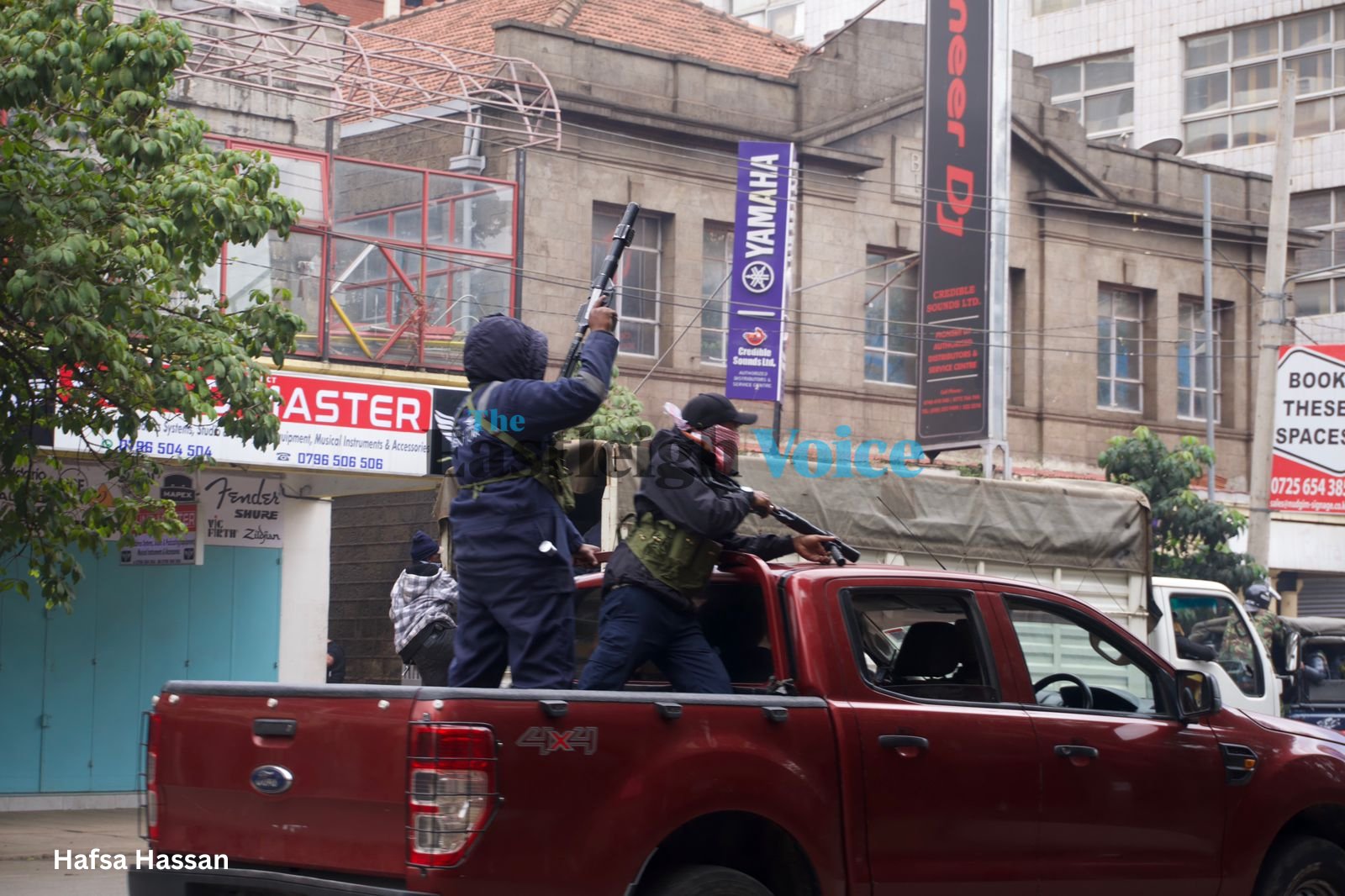 Plainclothes police officers fire teargas at protesters in Nairobi CBD, aboard an unmarked vehicle as others patrol on a police pick-up during the anti-government protests on Thursday, June 27, 2024. (Photo: Hafsa Hassan, EV)
Plainclothes police officers fire teargas at protesters in Nairobi CBD, aboard an unmarked vehicle as others patrol on a police pick-up during the anti-government protests on Thursday, June 27, 2024. (Photo: Hafsa Hassan, EV)
He said that a man he knew named George has been missing since the June 25 protests. He was last seen wearing a green helmet that said Kogalo, a football club, just after the crowd entered parliament.
A 27-year-old woman from Githurai said her 26-year-old brother, Mohammed Ramadhan Goti, a student in Mombasa, did not return home from protests on June 25: “We watched on television how things were bad that day. We tried to call him, but his phone was not going through. We have not found him to this day.”
Relatives of 19-year-old Kevin Namukhongo said he was arrested along Magadi road on June 25 and taken to Rongai police station at 2 p.m. along with other protesters. At 9 p.m., police moved other protesters to the Kiserian police station, leaving him at Rongai station, and he has not been seen since.
Peter Kamau Kameri, a 26-year-old handcart pusher at Githurai market, also went to protest on June 25 and never returned. His 25-year-old relative said: “He was last seen at parliament. We don’t know whether he was killed there. We have never found his body and police have told us nothing.”
A 23-year-old woman from Rongai said police arrested her together with her neighbour, 20-year-old Celine Dion, on June 27 and took them to different police stations. Dion’s whereabouts remain unknown.
The relatives of Khadija Hassan, a 30-year-old laundry woman from Githurai, said they don’t know her whereabouts since she joined the protests on June 25. Her 25-year-old niece said: “I went to Kenyatta, Mbagathi, and other hospitals and mortuaries but I did not find her. I have asked family in Mombasa, and they have not seen her.”
Salim Abubakar, 21, a student from Rongai, joined the protests on June 25 and was last seen around 4 p.m. by other protesters, but never returned home.
During protests on July 7, at around 4 p.m., two men came out of a small car and abducted 19-year-old Yusuf Yakub from a street in Rongai town. A 40-year-old relative who was with him said: “A car suddenly stopped, two people came out, threw him in the car, and drove off. They were in plain clothes. It happened too fast.”
Extrajudicial Killings and Obstruction of Justice
Based on multiple interviews with witnesses and families of victims, coupled with a detailed review of video clips of police use of force during protests, available online, Human Rights Watch found evidence suggesting that police unlawfully killed people during protests, including bystanders. The authorities violated international standards on policing protests by appearing to intentionally use lethal force where it was not strictly necessary to prevent an imminent threat to life, including police officers who shot directly into crowds and abducted peaceful protesters, several of whom turned up dead.
In one of its weekly updates in late July, the Human Rights Commission said that it had documented the killing of at least 73 people during protests. The number could be much higher, as more bodies were found later, and the bodies of other people whose killing was witnessed by others at parliament and elsewhere have yet to be found.
The Independent Policing Oversight Authority has yet to charge any police officer with any offense related to the protests. Two senior staff told researchers that, like the Human Rights Commission, it had received threats from senior government officials and has either slowed or halted investigations.
Interviews with journalists, protesters, and parliament staff and members who were either there on June 25 or viewed CCTV recordings of events, said that about an hour before protesters stormed parliament buildings, police shot at least six people dead along Parliament Road at the entrance to the Kenyatta Mausoleum and another two at the entrance to the senate buildings.
Witnesses also said that at 2:32 p.m., when protesters brought down the parliament fence wall on the Intercontinental Hotel side and surged toward the Mausoleum, plainclothes General Service Unit officers shot about seven protesters dead and threw their bodies behind the Mausoleum. The officers continued to shoot directly into the crowd, killing more than 10 other protesters at the Mausoleum, before the protesters overpowered them and surged into parliament.
The witnesses said that the plainclothes officers perched atop parliament buildings also shot scores of other people, including one Criminal Investigations officer and two soldiers in the head, along the corridor stretching from the entrance to the chambers of parliament. They said that police collected the bodies around midnight and took them to an unknown location. Most relatives of those known to have been killed inside parliament have yet to find their bodies.
A 22-year-old protester said he saw many of his colleagues killed by snipers on the roof of parliament: “Many people died at the grounds of parliament but what really hurt me was when my friends were shot dead. The bodies of my two friends John Waweru, 26 years old, and Teko, have not been found today. I saw both being shot in the head.”
A 23-year-old protester from Githurai said he protested alongside three other friends, including 23-year-old Philip, along Tom Mboya Street until 2 p.m. when protesters decided to invade parliament: “I was arrested before the invasion of parliament and spent the night at Langata Station. My close friend Philip was killed just outside parliament. I didn’t go to the funeral because I couldn’t face the mother.”
But other families, including that of 24-year-old Brian Musila, have not found the bodies of their relatives. A 25-year-old protester said he saw police shoot Musila together with a middle-aged dreadlocked man at the Mausoleum after protesters brought the wall down.
A 31-year-old man from Kibera said that his 24-year-old friend, Evans Kaguri, died instantly after police shot him in the torso along Kenyatta Avenue. A 22-year-old female protester from Kibera said she saw police shoot her 25-year-old friend, Lorrine Akinyi, in the stomach near the ribs, killing her instantly on Tom Mboya Street on June 25. A 28-year-old father of two said he saw a police officer in anti-riot gear step on the head of a protester along Tom Mboya Street on June 20, pinning him to the ground, and shoot him three times in the chest, killing him instantly.
Recommendations:
- The authorities should disband the multi-agency unit responsible for abductions and arbitrary arrests, and suspend officers and their commanders who could interfere with investigations.
- Parliament should adopt laws to enable the Human Rights Commission and police investigations agency to establish a tribunal consisting of Kenyan and non-Kenyan investigators, prosecutors, and judges to prosecute protest-related crimes.
- The UN and AU should urge and support Kenya to facilitate the establishment of an independent tribunal insulated from threats and manipulation by senior state officers.
Your tax-deductible gift can help stop.
Top Stories Today
Reader Comments
Trending
